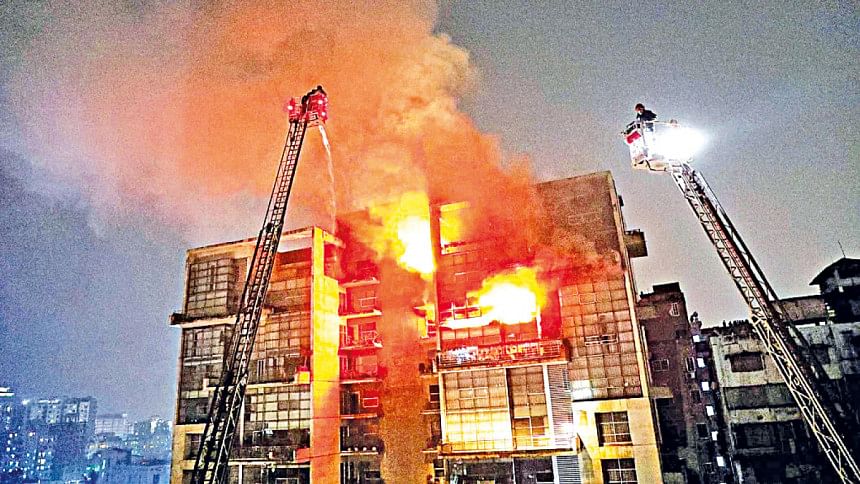All you need to know about fire safety regulations in Bangladesh

In the wake of two recent fire explosions in Narayanganj and Mogbazar, a surge of deadly fires has plagued the country with daily reports of fire explosions. From the Gulistan building explosion to the blasts at Science Lab and at Sitakundu, the country has witnessed a spate of deadly fires that have caused fear and anxiety among the people. With each new fire-related fatality, the public has grown increasingly alarmed and concerned about compliance with fire safety regulations. Considering this, this piece aims to illuminate the present legislative framework for fire safety and the reasons for non-compliance.
The first law worth noting in this context is the Bangladesh National Building Code (BNBC), 2020. This law has been subject to several amendments due to the past fire-related experiences. Part 4 of the Code covers the requirements for fire prevention. It specifies the general conditions of fire protection (Chapter 1), precautionary requirements (Chapter 2), provisions for exit (Chapter 3), and requirements necessary to minimise danger to life from fire, smoke, fumes, and so forth. Some of the vital fire safety provisions of the Code include:
(a) Fire-resistant construction: The Code mandates that all buildings must be constructed with fire-resistant materials that can withstand the spread of fire (Part III);
(b) Fire detection and alarm systems: The Code requires that buildings be equipped with fire detection and alarm systems that can detect smoke, heat, and fire and alert occupants in case of a fire (Part IV, Chapter 5);
(c) Means of escape: The Code requires buildings to have multiple means of escape, such as staircases, corridors, and exits, to enable occupants to evacuate quickly in case of a fire (Part IV, Chapter 3);
(d) Firefighting equipment: The Code mandates that buildings must be equipped with firefighting equipment such as fire extinguishers, fire hoses, and sprinkler systems to help control and extinguish fires (Part IV, Chapter 4);
(e) Smoke management systems: The Code requires buildings to have smoke management systems such as smoke vents, exhaust fans, and pressurisation systems to control the spread of smoke in case of a fire (Part IV, Chapter 3); and
(f) Fire drills and training: The Code mandates that building owners and occupants must conduct regular fire drills and training sessions to ensure that everyone is prepared to evacuate safely in case of a fire (Part 4, Chapter 1, Appendix B).
Then come the Fire Prevention and Extinguishing Act, 2003 and the Fire Prevention and Extinction Rules, 2014. Section 7 of the Act requires the approval of the Directorate General of Fire Service and Civil Defence for any structural design or layout of a multi-storied commercial building. Rule 22 of the 2014 Rules supplements the Act by requiring an occupancy certificate to ensure building compliance with safety requirements.
So, the question arises as to why there are still so many explosions despite the presence of such comprehensive laws. First, there is a lack of accountability due to the absence of an implementing authority. As per paragraph 12 of chapter 2 of part II of the Code, an authority has to be established who will work towards implementing the revised National Building Code, 2020. In the same chapter, it also mentions that there will be an office of building officials who will operate at the local levels. Unfortunately, such authorities are yet to have been formed even after two years of adopting the Code. Secondly, experts have opined that certain National Building Code modifications have rendered the Code more vulnerable. In this context, high-rise buildings with more than 10 floors are exempt from specific safety standards, including firefighting pump houses.
Furthermore, owners' non-compliance of the rules becomes one of the most significant obstacles to enforcing these regulations. The preliminary finding of the February Gulshan fire incident revealed that the 13-storied building was built without a proper fire safety plan, according to the standards laid out in the Act. Also, deliberate neglect on the owner's part regarding fire extinguishers, emergency exits, and other safety measures is rampant and causes the death of many people. Finally, the BNBC recommends fire drills quarterly, once, or twice a year, depending on the building type, to quickly escape a structure in the event of a fire. However, such a drill never happens, not even once.
Last year, the fire service officials in Dhaka evaluated 1,162 buildings and labelled 136 of them, as "extremely risky" and 499 as "risky" (The Dhaka Tribune, 9 March 2023), which is a cause for major concern. To prevent a spate of fatal fires, it is crucial to establish an effective authority for monitoring systems and collaboration at the local level, as it would not be feasible to control the fire concerns otherwise. Hence, a holistic method must be taken. Lastly, the public in general need to be made aware of the issue and taught the basics of firefighting regularly.
The Writer is an Official Contributor, Law Desk, The Daily Star.

 For all latest news, follow The Daily Star's Google News channel.
For all latest news, follow The Daily Star's Google News channel. 



Comments